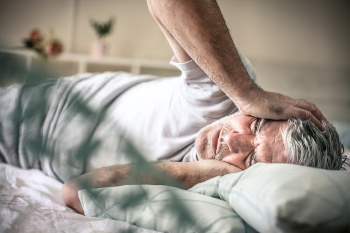Treating Peyronie’s Disease with Penile Stretching

Techniques that stretch the penis could be effective for treating Peyronie’s disease, according to a review of medical literature.
Peyronie’s disease occurs when scarring develops just below the skin of the penis. These areas form hardened plaques that limit flexibility. As a result, the penis bends. Sometimes, the curve is so severe that intercourse becomes extremely difficult or even impossible. Men may experience pain, penile shortening, and erectile dysfunction (ED).
There are two phases of Peyronie’s disease. First is the acute phase, when plaques form and the penis starts to bend. Erections may become painful. The chronic phase follows. At this point, the plaques and curve become stable and don’t typically worsen. Pain usually subsides during the chronic phase as well.
Treatment for Peyronie’s disease might include oral medications, injections of medicine directly into the plaques, and surgery. However, stretching therapies might be worth considering, scientists report.
They analyzed medical studies that focused on two stretching approaches:
- Traction therapy. Men who go this route wear a special device that pulls the penis in the opposite direction of the curve, thus keeping it straight. The device is worn for one hour a day.
- Vacuum erection devices (VEDs).Typically used to treat erectile dysfunction, a VED uses a pump to allow more blood to flow into the penis.
The study authors looked at research on traction therapy alone and in conjunction with other Peyronie’s treatments, like injections and surgery.
“[Penile traction therapy] has been successful in primary penile lengthening and curvature correction in the acute phase of [Peyronie’s disease],” they concluded. It might also help preserve penile length in men who undergo surgery. More research is needed on traction therapy combined with injections, however.
Traction devices are easy to find and use, the authors noted. But they may not be appropriate for all patients, and it is still not clear how long the devices should be used for best results. More study is recommended before traction therapy can be considered a “standard of care,” the researchers explained.
Less is known about VEDs to treat Peyronie’s disease. Studies of the approach after radical prostatectomy (surgical removal of the prostate gland) and before penile implant procedures suggest that VEDs may be effective, but further research is necessary.
“More basic and clinical research is required to clarify the role of penile stretching in [Peyronie’s disease], but with existing trials and research ongoing, the potential is encouraging,” the authors wrote.
The study was published online in Sexual Medicine Reviews in January 2019 as an article in press.
Resources
Sexual Medicine Reviews
Cowper, Matthew G., BS, et al.
“Penile Stretching as a Treatment for Peyronie’s Disease: A Review”
(Full-text article in press. Published online: January 4, 2019)
https://www.smr.jsexmed.org/article/S2050-0521(18)30118-5/fulltext
Urology Care Foundation
“What is Peyronie’s Disease?”
https://www.urologyhealth.org/urologic-conditions/peyronies-disease#Symptoms
You may also be interested in...
Other Popular Articles

What Is the Average Penis Size?
If you have ever wondered how your penis compares to others in terms of size, you are not alone. Many men are curious to know how their penises stack up compared to the average. Unfortunately, general curiosity can sometimes give way to full-on obsession and anxiety about penis size. This can be an unhealthy and often unnecessary fixation, especially because most men who think their penises are too small have perfectly normal-sized penises.

What Is Jelqing, and Does It Actually Work?
The term “jelqing” refers to a set of penis stretching exercises that some believe can make the penis bigger. Although the practice has gained attention and popularity in blogs and internet forums in recent years, there is no scientific evidence that it is an effective way to permanently increase the size of one’s penis. In fact, in some cases, jelqing may actually cause damage to the penis, so it is a good idea to get all the facts before setting off to try it.

What Is Sensate Focus and How Does It Work?
Sensate focus is a technique used to improve intimacy and communication between partners around sex, reduce sexual performance anxiety, and shift away from ingrained, goal-oriented sexual patterns that may not be serving a couple.

Can Sex Reduce Menstrual Cramps?
The SMSNA periodically receives and publishes ‘guest editorials.’ The current article was submitted by Mia Barnes, a freelance writer and researcher who specializes in women's health, wellness, and healthy living. She is the Founder and Editor-in-Chief of Body+Mind Magazine.
Having sex while you experience menstrual cramps is healthy and can provide significant benefits. While it might not be the first activity that comes to mind when your PMS or period cramping begins, many people enjoy sex to reduce menstrual cramps, experience increased pleasure and benefit from other advantages. Learn more about having sex while menstrual cramps are happening and how it can help your body.

How Long Does It Take the Average Man to Ejaculate?
On average, it takes a man between 5 to 7 minutes to orgasm and ejaculate during sexual intercourse.

The Effect of Regular Aerobic Exercise on Erectile Function
Erectile dysfunction (ED) is the inability to achieve or maintain an erection sufficient for satisfactory sexual activity. As men get older, their erectile functioning may naturally decline due to changes in testosterone levels, cardiovascular functioning, and the potential development of other chronic medical conditions that become more common with age.
You are prohibited from using or uploading content you accessed through this website into external applications, bots, software, or websites, including those using artificial intelligence technologies and infrastructure, including deep learning, machine learning and large language models and generative AI.

